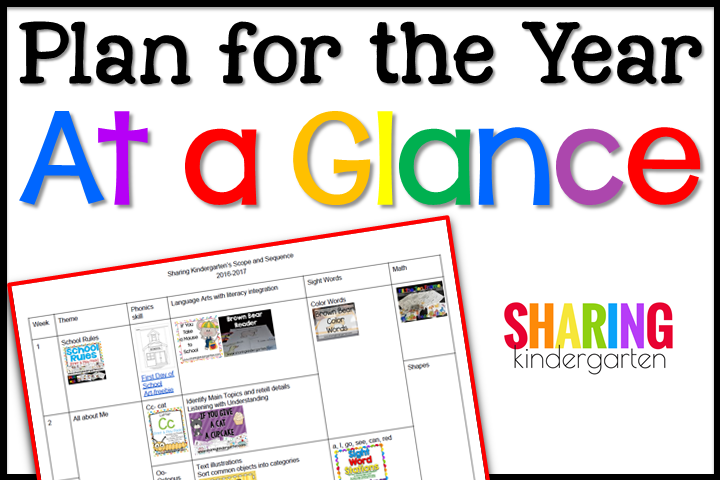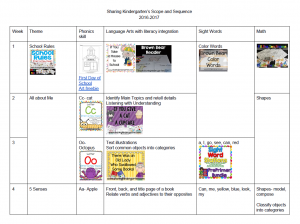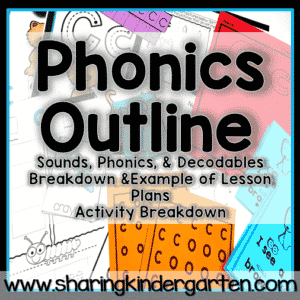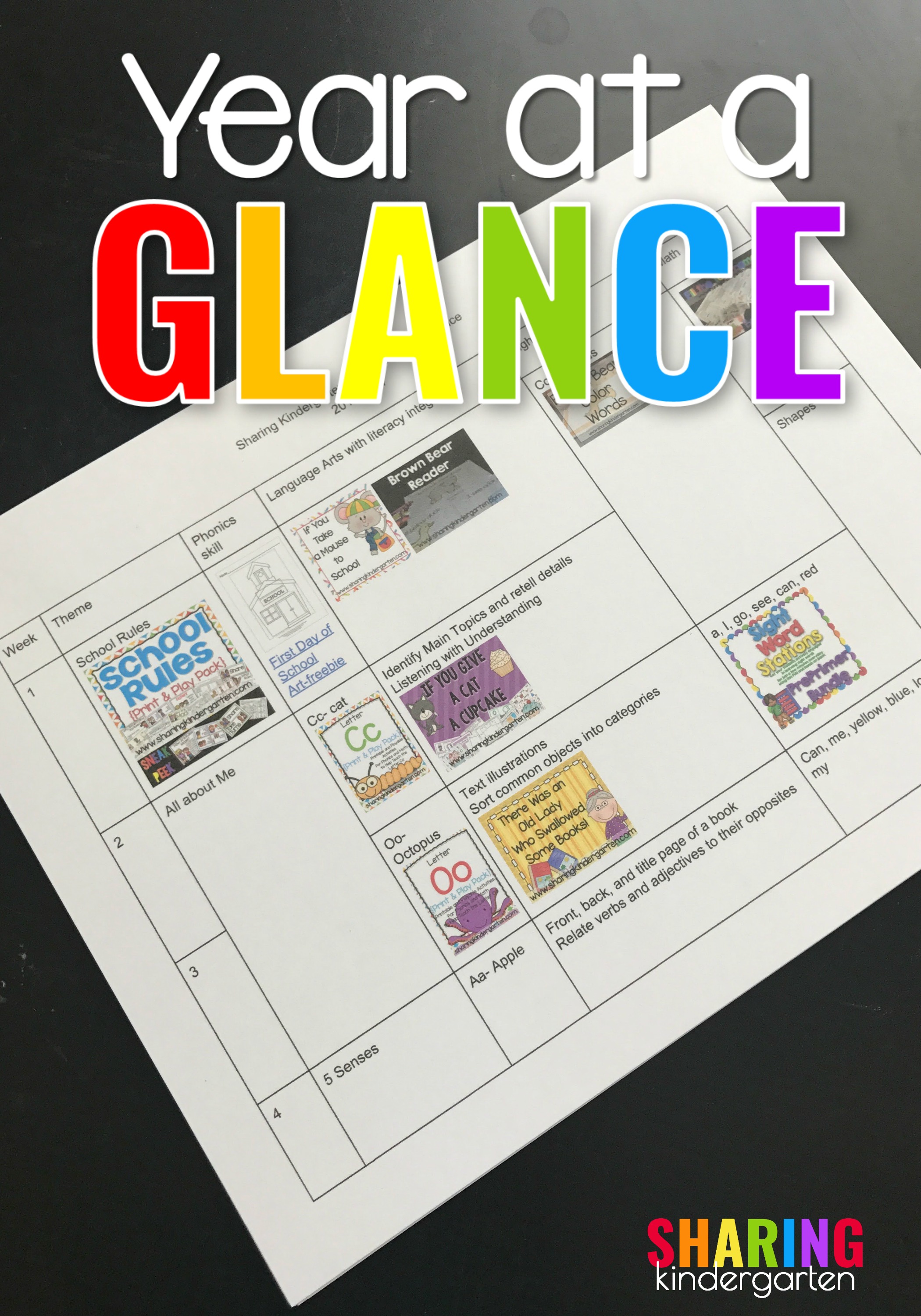Do you have a state, county, or even school scope and sequence to follow? What does your Kindergarten phonics Scope and sequence look like? Wait, what IS a scope and sequence in the first place?
Effective planning is the cornerstone of productivity and success, enabling individuals to allocate their time and resources wisely. One powerful approach to long-term planning in education is utilizing a scope and sequence, a method that provides a structured framework for organizing and prioritizing your goals and tasks throughout the year. In this blog post, we will explore how to harness the potential of a Kindergarten phonics scope and sequence to plan your entire year in advance, empowering you to achieve your objectives with efficiency and clarity.
The Year at a Glance
A scope and sequence is a map of the school year, detailing the plan of when you will teach each and every standard. It keeps all the teachers at the same pace. It sets a guide for assessing. It also ensures you cover all required information in an organized fashion. Essentially it is a huge time-saving tool every teacher should have. This can also be called a pacing guide, phonics outline, or a Kindergarten Phonics Scope and Sequence. Additionally, our first grade phonics scope and sequence take into consideration the Kindergarten scope and sequence so they can properly build off each other.
Understand the Concept of Scope and Sequence
A scope and sequence is a planning tool widely used in education and project management. It involves breaking down your goals, projects, or tasks into specific scopes, which represent larger milestones, and arranging them in a logical sequence. By visualizing your entire year’s plan, you gain a comprehensive overview of your objectives, ensuring a smooth progression from one milestone to the next.
In Kindergarten specifically, it is critical to set up a pacing guide according to the Kindergarten Phonics Scope and Sequence, since phonics is our foundation for reading and sets the pace for everything else.
Who Creates a Scope and Sequence?
Ideally, you and your team should play a role in creating a logical and usable Kindergarten Phonics scope and sequence for yourselves. It is a fluid map that should be altered and changed around as needed. I recommend making notes on the map so you can improve upon it year after year.
Many school districts have pacing guides that are made by representatives from that grade level across many schools. This is another way to involve all teachers who will use the guide in the Kindergarten phonics scope and sequence. I highly recommend school districts to have phonics scope and sequence by grade level.
Define Your Goals and Objectives
Begin by clarifying your long-term goals and objectives for the year. Are you aiming to advance your career, learn a new skill, or launch a personal project? Write down your goals in a clear and concise manner. By having a well-defined destination, you can better identify the necessary scopes to achieve it.
Break Down Goals into Scopes
Next, dissect your goals into smaller, manageable scopes. Consider each scope as a significant milestone or phase that contributes to the overall achievement of your goal. These scopes should be specific, measurable, attainable, relevant, and time-bound (SMART). By dividing your goals into actionable components, you reduce overwhelm and enhance your focus on individual steps.
Arrange Scopes in a Logical Sequence
Once you have determined the scopes for each of your goals, it’s time to arrange them in a logical sequence. Think about the dependencies and relationships between different scopes. Certain scopes may need to be completed before others can begin. Establishing a well-thought-out sequence ensures a smooth flow of progress and helps you allocate time and resources effectively.
Set Timeframes and Deadlines
Assigning timeframes and deadlines to each scope is essential for maintaining accountability and tracking progress. Determine how long you anticipate each scope will take to complete and set realistic deadlines accordingly. Be mindful of potential constraints, such as external commitments or seasonal fluctuations, that might impact your schedule. Consider leaving some buffer time for unexpected circumstances.
Create a Visual Representation
Visualizing your scope and sequence plan helps to reinforce your understanding and motivation. Consider using a calendar, a project management tool, or a spreadsheet to map out your year-long plan. Highlighting different scopes with color codes or symbols can provide a visual distinction and make it easier to comprehend the progress and interdependencies.
Regularly Review and Adjust
While the scope and sequence plan provides a roadmap for the year, it is essential to remain flexible and open to adjustments. Life is dynamic, and circumstances may change. Regularly review your plan, assess your progress, and adapt as necessary. Being adaptable allows you to respond effectively to unforeseen opportunities or challenges that may arise along the way.
What Does Your Kindergarten Phonics Scope and Sequence Look Like?
Many of you have asked me about my Kindergarten Phonics scope and sequence. Since I am teaching at a new school this year, there are some changes from things I have done in the past. I will gladly share with you this work in progress.
{Click the image below or HERE to grab a copy of my scope and sequence.}
I have inserted the unit I have created so you can see at a glance what materials I use and WHEN I use them. This also helps me to see what units I need to create activities for since I have tons of open holes.
Two Letters a Week Sequence
My county has issued faster-paced phonics instruction. I had to redo my pacing guide to show this. You can grab this NEW updated guide with two letters a week here. Some people ask why I don’t do a letter a day. Simple: I always use data to drive my instruction. I always have more letters introduced and on my blending board based on student data than I have taught. But once we cover a letter, we do not have time to go back to it. So I cover a letter ONCE, for a few days, then move on. I continue to do spiral reviews and MTSS, but I do not reteach a letter whole group.
Additionally, I have updated my Kindergarten Phonics Scope and Sequence do build specifically to include a phonics outline that includes a breakdown of sounds, phonics, and decodable. This uses the Orton-Gillingham phonics scope and sequence for Recipe for Reading. I am updating it for the new OG Phonics sequence in July. This is a free phonics scope and sequence.




I love what I see of your scope and sequence above. Is it possible for you to email me a copy of your years scope and sequence? Or tell me where I can find it?
Thanks so much
Just click on the link above to download mine now. 🙂
Is there a link for all the materials you use with this scope and sequence?
YEP… download the file and all the images are CLICKABLE!